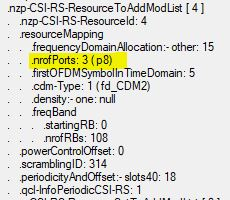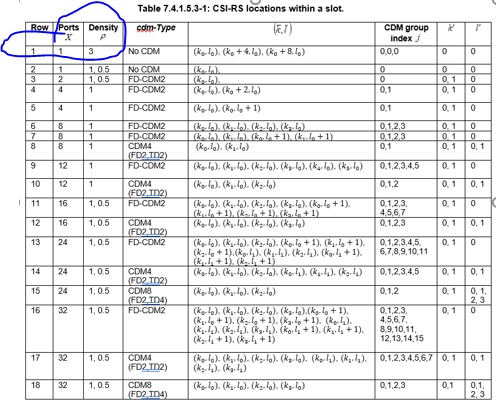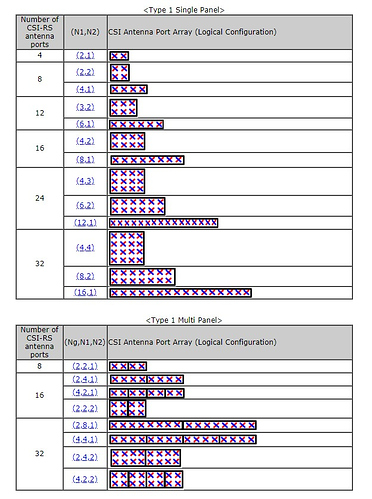Hello Experts.
What should be CSI RS resource configuration in the network?
Number of RB allocation should be all PRB in BW.
For example if we use 53 RB out of 276 RB in 100 Mhz BW what are the pros-cons of it?
This is not the correct nzp configuration for the csi-rs ports.
There should be one nzp with nr of ports=4,8,12, 16 etc.
That one is for csi-rs ports.
This is how a nzp is configured for csi-rs ports. Other=15=1111 gives the configuration of the 8 csi-rs ports:

Thanks @RFSpecialist, that I understand.
But my query is what is the meaning of noofRB in your case it is 108 RB so you have taken all RB in BW?
As per 3gpp smallest configuration can be 24 RB.
If we set it < all PRB in BWP what will be the pros-cons?
Yes, it means that nzp csi-rs will eb transmitted in all 108 PRBs.
Correct but what if i set it = 52RB?
Or it must be all 108 RB?
You cannot, there is no parameter that allows you to set the number of PRBs as per your convenience.
I mean for the csi-rs ports.
Yes, there is a parameter CSIrsRB allocation but if we set < all RB how CSI RS will work it should be with all PRB?
Why is this flexibility allowed?
If CSI RS port = 1 how many nzp resource do we need?
It should be 4, right?
It is impossible.CSI-rs ports always starts from 4 and above.
Yes, in Nokia we have parameter and there are 2 option 52 or BW (ALL RB).
csi-rs ports cannot be configured to 1.
Yes it is Row index 1 = CSI RS port 1.
We can configure CSI RS port =1.

Look at sharetechnote table:
The table you presented is for nzp configuration with 1 single row for example.
In reality minimum 4 csi-rs ports are configured always.
Yes in Sharetechnote its not there as per 3gpp 1 port configuration is available with raw 1,2 3…
In reality 4 csi rs port are configured.
But I am taking it as an example.
csi-rs ports are for various purposes.
The ones for PMI reporting needs to be at least 4 csi-rs ports.
Gents, Summary…
Number of time domain symbols: Each CSI-RS resource occupies 1 to 4 symbols in the time domain.
Time domain position: The TRS supports the following symbol positions: {4,8}, {5,9}, and {6,10}.
The positions of other supported symbols are {0–13}.
The specific positions are configured by higher layer parameters.
Frequency domain position: It is configured by the CSI-RS-ResourceMapping parameter.
Number of supported ports: {1,2,4,8,12,16,24,32}
nzp csi-rs ports are setup for various purposes.
Those for PMI reports are always minimum 4.
The other with only 1 port are for other purposes.
It is not beamforming when csi-rs ports = 1.
As I have seen in Huawei docs, mmwave do support csi-rs beams.
For example in 26 GHz, HAAU5213 there are 16 SSB beams and 64 csi-rs beams.
Not sure for FR1.
Agreed.
Even in FR1 there is no setting for CRS port-1 in Huawei …
Indicates the maximum number of ports for CSI measurement in a cell.
The value 0 indicates fixed 8-port CSI-RS measurement for low-frequency TDD cells, fixed 4-port CSI-RS measurement for high-frequency 4T4R TDD cells, and fixed 8-port CSI-RS measurement for high-frequency 8T8R TDD cells.
The value 1 indicates fixed 2-port CSI-RS measurement.
The value 2 indicates fixed 4-port CSI-RS measurement.
The value 3 indicates fixed 8-port CSI-RS measurement.
The value 4 indicates fixed 16-port CSI-RS measurement.
The valid value range of this parameter is 0, 3, and 4 for cells served by low-frequency modules with transmit capability higher than 8T. The valid value range of this parameter is 0 to 2 for cells served by high-frequency 4T modules. The valid value range of this parameter is 0 to 3 for cells served by high-frequency 8T modules. If this parameter is set to a value beyond the valid value range, the value 0 takes effect. When this parameter is modified, services are interrupted for 0.1 minute.
This parameter does not take effect in cells served by 2T/4T FDD modules, cells served by low-frequency 1T/2T/4T/8T TDD modules, and cells served by high-frequency 2T TDD modules. 2- or 4-port CSI-RS measurement always applies to 2T/4T FDD modules. 1-, 2-, 4-, or 8-port CSI-RS measurement always applies to low-frequency 1T/2T/4T/8T TDD modules. 2-port CSI-RS measurement always applies to high-frequency 2T TDD modules.
What is important is to make a clear distinction between csi-rs ports and csi-rs beams.
Those 2 are different things.
Thanks @ajaymsfather.
This pairing CSI RS resource (4,8) ( 5,9) and (6,10) are for FR1 and this is just a time domain configuration and 4 npz resource need 2 consecutive time slot i & i+1.
So with this configuration we can go upto 6 SSB for CSI RS tracking.
My question is why CSI RS resource in frequency domain nrofRB is limited or less thn all RB in BW configurable?
@meo, as per your question, what SSB has to do with CSI-RS?
Are not related in any way.
SSBs are related with CSI-RS beams.
For example for 1 SSB coverage there can be 4 CSI-RS beams.
But not csi-rs ports.
